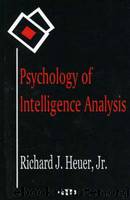Psychology of Intelligence Analysis by Richard Heuer

Author:Richard Heuer [Heuer, Richard]
Language: eng
Format: epub
Tags: Bias, Heuristics, Military, Psychology
Published: 2016-05-10T16:00:00+00:00
Analysis of Competing Hypotheses
* * *
Analysis of competing hypotheses, sometimes abbreviated ACH, is a tool to aid judgment on important issues requiring careful weighing of alternative explanations or conclusions. It helps an analyst overcome, or at least minimize, some of the cognitive limitations that make prescient intelligence analysis so difficult to achieve.
ACH is an eight-step procedure grounded in basic insights from cognitive psychology, decision analysis, and the scientific method. It is a surprisingly effective, proven process that helps analysts avoid common analytic pitfalls. Because of its thoroughness, it is particularly appropriate for controversial issues when analysts want to leave an audit trail to show what they considered and how they arrived at their judgment.84
*******************
When working on difficult intelligence issues, analysts are, in effect, choosing among several alternative hypotheses. Which of several possible explanations is the correct one? Which of several possible outcomes is the most likely one? As previously noted, this book uses the term "hypothesis" in its broadest sense as a potential explanation or conclusion that is to be tested by collecting and presenting evidence.
Analysis of competing hypotheses (ACH) requires an analyst to explicitly identify all the reasonable alternatives and have them compete against each other for the analyst's favor, rather than evaluating their plausibility one at a time.
The way most analysts go about their business is to pick out what they suspect intuitively is the most likely answer, then look at the available information from the point of view of whether or not it supports this answer. If the evidence seems to support the favorite hypothesis, analysts pat themselves on the back ("See, I knew it all along!") and look no further. If it does not, they either reject the evidence as misleading or develop another hypothesis and go through the same procedure again. Decision analysts call this a satisficing strategy. (See Chapter 4, Strategies for Analytical Judgment.) Satisficing means picking the first solution that seems satisfactory, rather than going through all the possibilities to identify the very best solution. There may be several seemingly satisfactory solutions, but there is only one best solution.
Chapter 4 discussed the weaknesses in this approach. The principal concern is that if analysts focus mainly on trying to confirm one hypothesis they think is probably true, they can easily be led astray by the fact that there is so much evidence to support their point of view. They fail to recognize that most of this evidence is also consistent with other explanations or conclusions, and that these other alternatives have not been refuted.
Simultaneous evaluation of multiple, competing hypotheses is very difficult to do. To retain three to five or even seven hypotheses in working memory and note how each item of information fits into each hypothesis is beyond the mental capabilities of most people. It takes far greater mental agility than listing evidence supporting a single hypothesis that was pre-judged as the most likely answer. It can be accomplished, though, with the help of the simple procedures discussed here. The box below contains a step-by-step outline of the ACH process.
Download
This site does not store any files on its server. We only index and link to content provided by other sites. Please contact the content providers to delete copyright contents if any and email us, we'll remove relevant links or contents immediately.
Rewire Your Anxious Brain by Catherine M. Pittman(17589)
Talking to Strangers by Malcolm Gladwell(11877)
The Art of Thinking Clearly by Rolf Dobelli(8842)
Mindhunter: Inside the FBI's Elite Serial Crime Unit by John E. Douglas & Mark Olshaker(7834)
Becoming Supernatural by Dr. Joe Dispenza(7106)
Change Your Questions, Change Your Life by Marilee Adams(6641)
The Road Less Traveled by M. Scott Peck(6635)
Nudge - Improving Decisions about Health, Wealth, and Happiness by Thaler Sunstein(6633)
The Lost Art of Listening by Michael P. Nichols(6474)
Enlightenment Now: The Case for Reason, Science, Humanism, and Progress by Steven Pinker(6405)
Win Bigly by Scott Adams(6311)
Mastermind: How to Think Like Sherlock Holmes by Maria Konnikova(6236)
The Way of Zen by Alan W. Watts(5800)
Daring Greatly by Brene Brown(5641)
Grit by Angela Duckworth(4737)
Big Magic: Creative Living Beyond Fear by Elizabeth Gilbert(4723)
Men In Love by Nancy Friday(4324)
Flow by Mihaly Csikszentmihalyi(4052)
The Four Tendencies by Gretchen Rubin(4024)
